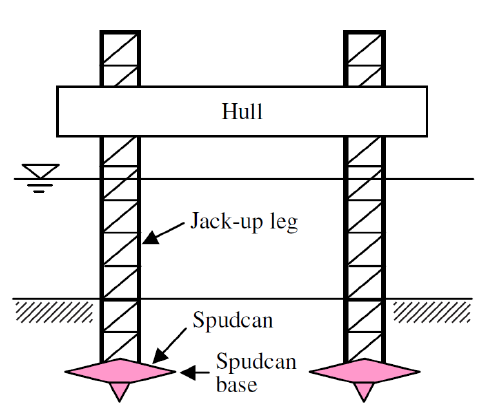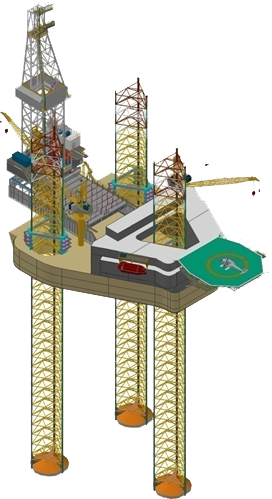Jack up units have footings to increase bearing area of each leg. This will result in reduction of load capacity of soil to deliver a firm foundation for a jack up rig to stand and transfer weight to the sea floor. With two different types of footing, spud cans and mats, it is important to know the main differences that exist.

Mat Footings
With a mat footing, every single leg will sit on the same footing. Typically, flat on both sides, they are normally a rectangular shape with buoyancy chambers; when the mat is submerged, these are quickly flooded. Compared to spud cans, this option exerts slightly less bearing pressure on the soil and this helps areas in which high bearing loads cannot be supported by the soil. After this, there is a second advantage in that it is the most buoyant option of the two with afloat transit mode. In theory, this has the potential to improve variable load carrying capabilities.

Figure 1 – Mat Footing Jack Up Rig
On the flip side, there are some disadvantages to mat footings starting with the lack of options for uneven seabeds or any with sloping. When placed on a seabed of this type, the mat will bend in certain areas to find the surface; in order to thrive with high bending loads, the structure would have to be extremely heavy. Furthermore, mat footings are near enough redundant whenever there are pipelines or debris in place.
Finally, it is noted that the mat needs to be flooded when transitioning from afloat to the on-bottom function. If not done correctly, the flooding can cause loss of stability and large heeling moments. Then, the footing needs to be pumped of all water when re-floating the unit and this means the need for equipment that simply isn’t necessary with independent-legged units.
Spud Can Footings
Whenever there are independent spud can footings, the number of legs and spud cans is always equal. Typically, they will offer a conical structure where the tops and bottoms both slope. On top, the slope helps to remove any collected mud whenever there is deep penetration. On the bottom, the slope ensures penetration even in the stiffest of soils. When submerged, they are normally designed with free flooding in mind but, for internal inspection, they can be pumped dry.

Figure 2 – Spud Can Diagram for a Jack Up Rig (Lee and Randolph, 2011)
Just as we saw with mat footings, there are some advantages to spud can footings starting with their use on various seabed types. Whether the soil is soft or hard, whether the seabed slopes, or even when there are pipes and various other obstacles, the spud can footings excel. Although there is a slight weak point with large slopes that have hard soil, they are generally the ‘all-rounder’ which shows the difference with mat footings. Furthermore, no equipment is required nor is the need for ballasting sequences; when transporting the unit, there are some rigs that even see the spud cans retract into the hull.

Figure 3 – A Jack Up Rig with Spud Can Footing (http://www.saff-rosemond.com, 2018)
Compared to mat footing units, soil penetration for spud can footing is deeper because the bottom bearing pressure generated by spud cans is higher than mat footings. Since the bearing pressure are high, spud cans leave foot prints in soft soil areas. Later on, if there is another jack up rig coming back to work in this area, the old foot print can lead to horizontal force which will bring the new rig back into an old position. It is imperative that engineers must consider the risk of unintentionally moving back into the old holes to understand if this will stop the whole operation or not.
References
Maritimecommunications.com. (2018). Bethlehem Beaumont ShipyardTo Build Offshore Rig ForHouston Offshore International. [online] Available at: http://www.maritimecommunications.com/world-ports-~2d-top-20/bethlehem-beaumont-shipyard-international-209503 [Accessed 12 Aug. 2018].
Jerman, J. (2018). Spudcan foundation and the drilling rig. [online] www.researchgate.net. Available at: https://www.researchgate.net/figure/Spudcan-foundation-and-the-drilling-rig-Lee-and-Randolph-2011_fig8_273761420 [Accessed 12 Aug. 2018].
JACK UP – ROSEMOND-SA20 JACK-UP DRILLING RIG DESIGN. (2018). Rosemond-emi. [online] Available at: http://www.saff-rosemond.com/Rosemond-JackUp-Project.html [Accessed 12 Aug. 2018].
Mitchell, R.F., Miska, S.Z. and Aadnoy, B.S. (2012) Fundamentals of drilling engineering. Richardson, TX: Society of Petroleum Engineers.
Bork, K. (1995). The rotary rig and its components. Austin: Petroleum extension service. Division of continuing education. University of Texas at Austin.
Davis, L. (1995). Rotary, kelly, swivel, tongs, and top drive. 1st ed. Austin: Petroleum extension service. Division of continuing education. University of Texas at Austin.
Source: Dilling Formulas and Drilling Calculations


